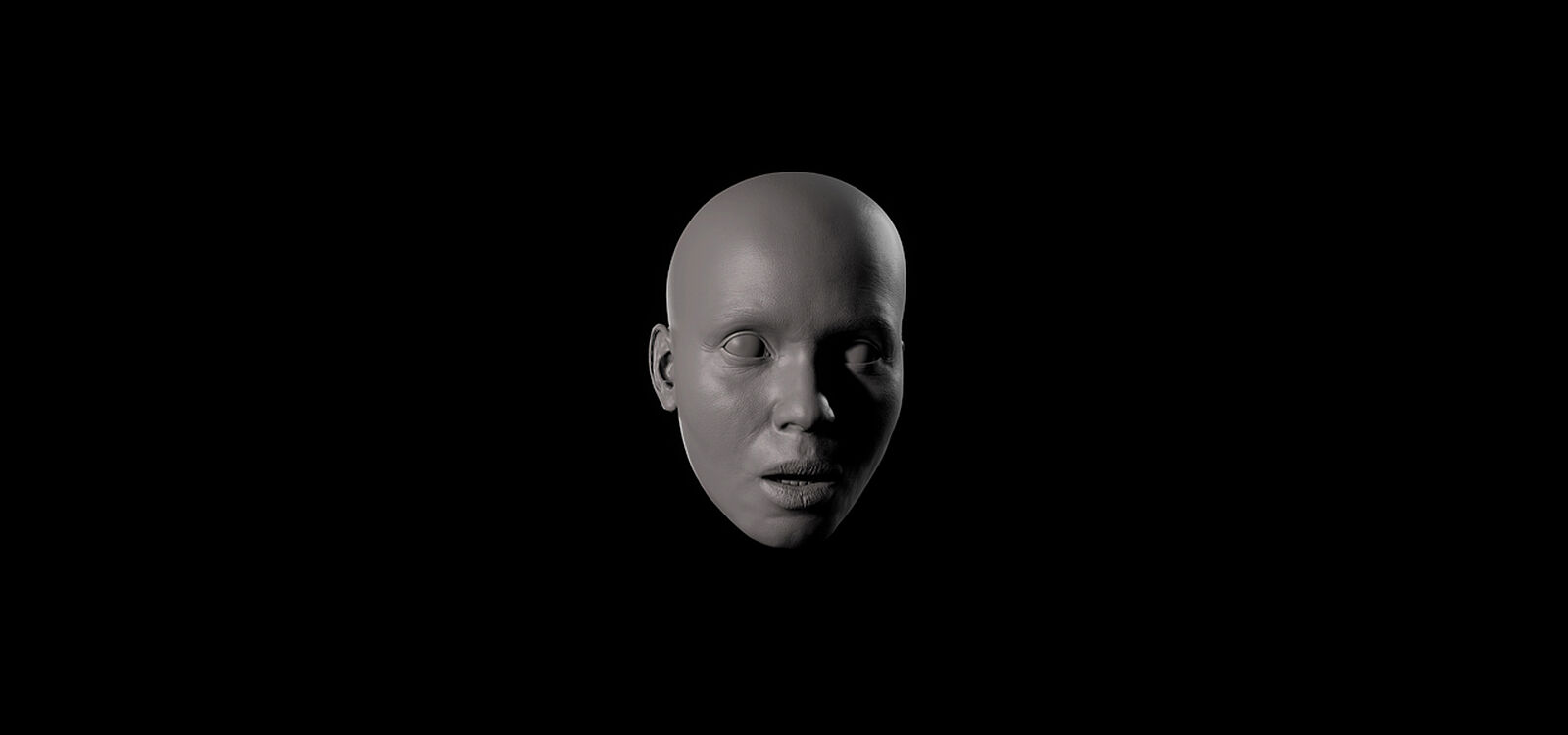
MAX BECKMANN / OMER FAST ABFAHRT
08.10. – 10.01.2021
Erstmals steht eine einzelne Zeichnung im ästhetischen Fadenkreuz einer Szenographie des international renommierten Filmemachers Omer Fast. Max Beckmann zeigt sich in dem doppelseitig ausgeführten Selbstbildnis von 1917 als rekonvaleszenten Kriegsveteran. Der Künstler war 1915, nach einem erlittenen Nervenzusammenbruch, vom aktiven Kriegsdienst als Sanitäter freigestellt worden. Zwei Jahre später noch scheint es so, als dass ihn die Bilder gesehener Kriegsgreuel in seiner Gedankenwelt wieder und wieder heimsuchen und ihn auch äußerlich zerrütten. Sie machen es ihm schwer, einen Ausweg aus seiner innerlich aus den Fugen geratenen Welt hin zu einem geordneten und emotional stabilen Zivilleben zu finden.
Omer Fasts installative Recherche greift diesen offensichtlichen Schwebezustand zwischen Realität und Wahn in Beckmanns Porträt auf und überführt ihn in unsere eigene Lebens- und Bilderwelt.
For the first time, a single drawing is at the aesthetic crosslines of one of the sets of the internationally renowned filmmaker Omer Fast. Max Beckmann presents himself in his 1917 double-sided self-portrait as a convalescent war veteran. In 1915, after suffering a nervous breakdown, Beckmann was released from active military service as a medic. Two years later, it appears as though the visions of witnessed war crimes were haunting his mind and causing harm to his body as well. The visions make it hard for him to escape from his shattered world and return to an orderly and emotionally stable civilian life.
Omer Fast’s installation investigates this obviously precarious state between reality and madness in Beckmann’s portrait and carries it over to our own lives and visual experience.
Beim Eintreten scheint der ehemalige Paradegang für Graphik wie verlassen. Die gläsernen Schreine bergen jetzt einzig Relikte unserer Alltagskultur, die wie durch Geisterhand inszeniert, ein ästhetisches Eigenleben zu entwickeln scheinen. Ein zurückgelassenes Handy, dort, wo kurz zuvor noch gearbeitet wurde, offenbart eine obsessive private Bildersammlung. Offen bleibt, ob die Zurschaustellung von Handydaten hier als Angriff auf die Privatsphäre zu lesen oder aber als Offenlegung eines Straftatbestands zu verstehen ist. Garantiert führt uns die Bilderflut unsere eigene Sucht nach Bildern jenseits der analogen Welt vor Augen. Ein Handyfilm in einer zweiten Vitrine gibt sich über einen beigefügten zeichnerischen Steckbrief eines aneinander gefesselten Paars als ein re-enactment der rechten Seitentafel von Beckmanns martialischem Triptychon Abfahrt (1932–35) zu erkennen. Das hier anklingende Bilddrama der Flucht aus einer katastrophalen Lebenswelt hinein in eine verheißungsvolle Zukunft ist ein Schicksal, das Beckmann am eigenen Leib erlebt hat und das heute für hunderttausende von Menschen zur Lebenswirklichkeit geworden ist. Vor diesem Hintergrund changiert der Ausstellungstitel zwischen lichter Hoffnung und verdunkelter Prophezeiung.
Upon entering the corridor flanked by vitrines, formerly a parade ground for graphic art, appears deserted. The display cases solely hold relics from our daily life that look as if arranged by invisible hands and as if they had developed a life of their own. In a spot, where work seems to have just been dropped, a deserted mobile phone plays an obsessive private collection of images. It is uncertain if this display of digital data is a violation of privacy or the disclosure of a crime. Either way, this flood of images reminds us of our own addiction to images from beyond the analog world. In a second vitrine, a nearby sketch of a tied couple helps us decipher a film on a mobile phone as a re-enactment of the right panel of Beckmann’s menacing triptych Abfahrt (Departure, 1932–35). This motif reflects the drama of flight from a catastrophic world into a promising future as Beckmann himself had experienced it and as hundred-thousands of people are experiencing it today. With this is mind, the exhibition’s title oscillates between bright hope and dark prophecy.
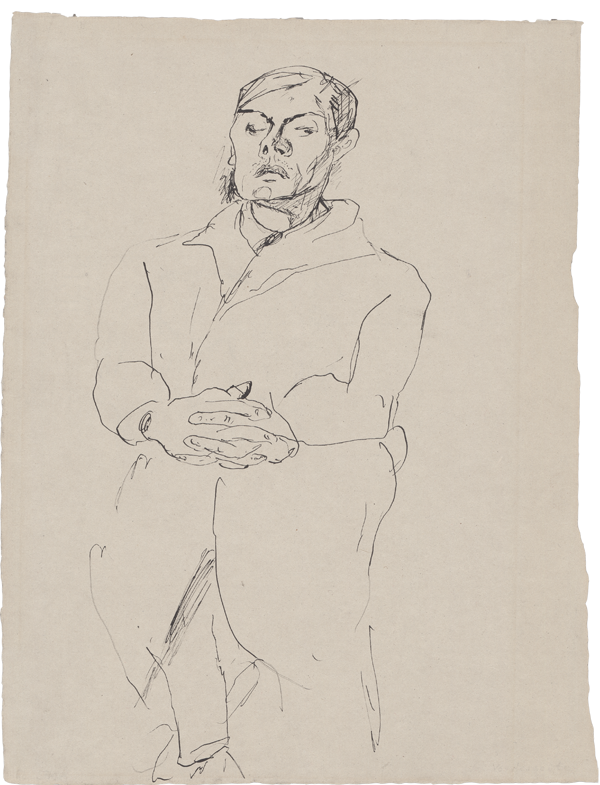
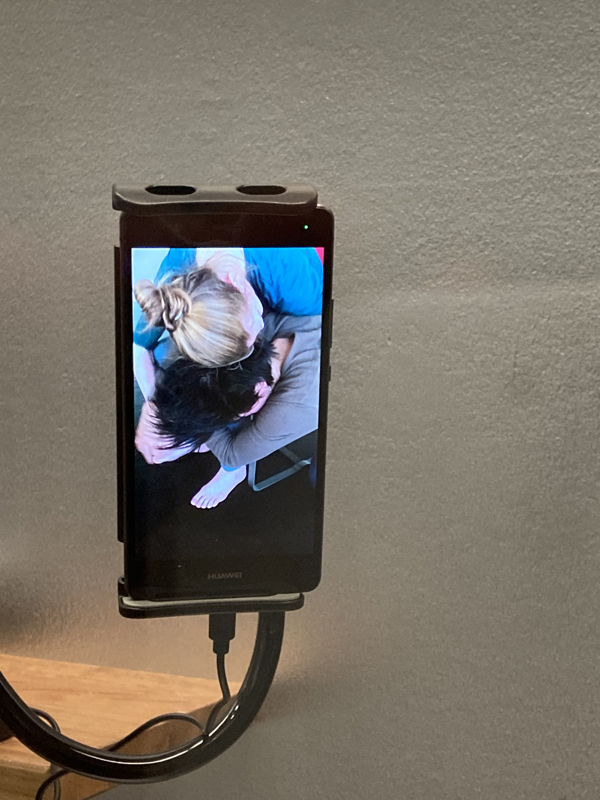
In der sich anschließenden Wohnung, die weder bewohnt noch unbewohnt scheint, kann man sich nicht sicher sein, ob sie nur renoviert wird oder für immer aufgegeben und sich selbst überlassen wurde. Im Wohnzimmer laufen Fernsehbilder von einer sagenhaften Geschichte, in der ein Geist das Schicksal der Menschen vorbestimmt. Im sich anschließenden Schlaf- und Kinderzimmer – ehemals Orte der Geborgenheit – erzählen professionelle Bildfahnder (content manager und super recognizer) von ihrer Arbeit, die unsere Lebenswelt vor den Untiefen menschlicher Phantasien schützen wollen, sie selbst aber aus ihrer Lebensbahn geworfen hat.
The adjoining apartment seems neither deserted nor inhabited. We cannot be certain if it is undergoing renovation or was departed for good and left to rot. In the living room the TV set shows the fabled story of a ghost that determines people’s fates. In the adjoining master and children’s bedrooms – formerly havens of safety – professional content managers and super recognizers talk about their work that is meant to protect our lives from the abysses of human imagination but that has thrown them off track in their own lives.
Beim Verlassen der Wohnung wird man im Hinterhof von einer Wolke unzähliger Beckmann- Porträts eingeholt. Rätselhaft bleibt, wer sie geschaffen hat. Offenbar treiben hier immer noch vergangene Gedankenbilder gleich Wiedergängern ihr Unwesen. Im anschließenden Videoraum, der wie ein stillgestelltes Sommerfest erscheint, erzählt ein weiterer Film eine Geschichte zwischen Traum und Wirklichkeit.
Omer Fasts Werk Abfahrt ist ein Angebot an den Betrachter, Versatzstücke aus Max Beckmanns Lebens- und Bilderwelt einmal anders zu erfahren und die verblaste Matrix der Vergangenheit an der einen oder anderen Stelle mit dem eigenen Leben und den Lebenserfahrungen abzugleichen. Am Ende des Rundgangs kann man sich fragen, ob man Beckmanns Selbstbildnis sitzend, mit gefaltenen Händen noch mit denselben Augen sieht.
Upon leaving the apartment for the backyard, we are enveloped there by a cloud of countless Beckmann portraits. It is a mystery who created them. Apparently, past mental images are haunting this place like revenants. In the video room next door, which looks like the film still of a summer fete, another film tells a story that vacillates between dream and reality.
Omer Fast’s work Abfahrt is an offer to visitors to experience motifs of Max Beckmann’s life and art in a different manner and to check, in one spot or another, the faded matrix of the past against our own lives and experiences. At the end of the tour, we may ask ourselves if we still see Beckmann’s Self-portrait seated, hands folded as we did before.
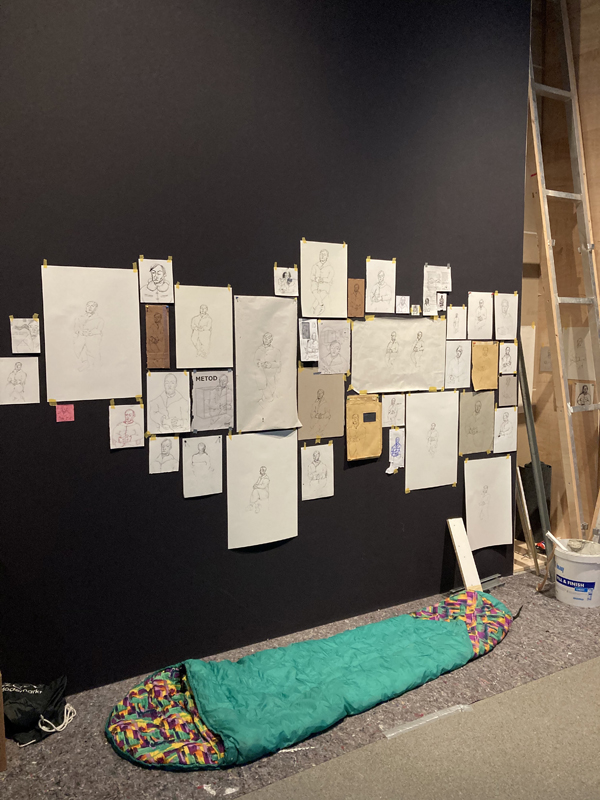
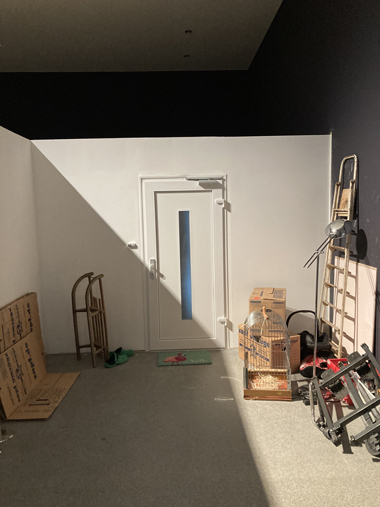

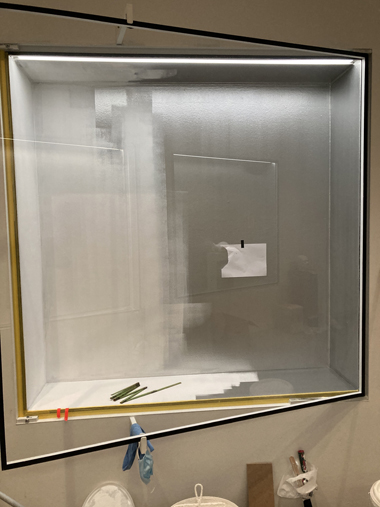
Podcast zur Ausstellung / Exhibition podcast
Wichtige Information
Bitte beachten Sie: Kein Eintritt für Personen unter 16 Jahren aufgrund sensibler Inhalte.
Aufgrund der Restriktionen im Zusammenhang mit Corona erhalten jeweils nur sechs Personen Zutritt zur Ausstellung. Hierdurch können sich Wartezeiten für Besucher der Ausstellung ergeben.
Wir danken für Ihr Verständnis.
Important Information
Please be advised that persons under 16 years of age (alone or in the company of adults) are not admitted in the exhibition due to sensitive content.
Due to Corona restrictions, only six visitors are admitted to the exhibition at any one time. This may cause a wait for those wishing to be admitted.
We apologize for any inconvenience.
Credits
Abfahrt
A solo exhibition by Omer Fast
Commissioned by Michael Hering, Direktor, Staatliche Graphische Sammlung, München
Scenography: Heike Schuppelius
Scenography Assistance: Anna Knöller
AV Technician: Radek Pater
Ausstellungsaufbau: Karl-Heinz Francota Staat, Joe Hölzner, Rafael Diaz Noguero, Bernhard Eglmeier
Builder: Rafal Schmidt, Slawek Kwasny, Slawek Piech, Andrzes Kosek, Sylwester Oayva
Guston Sculpture reproduction: Julia Heppner, Sophie Ilg
Installation assistance: Laurel Severin
Research assistance: Jonas Beile
Pedestals: Christian Veit
AV Equipment: Eidotech GmbH
Full 3D Productions: Mimic Productions, Berlin
Danke an Frieder Schlaich, Anna Bitter und Irene von Alberti / Filmgalerie 451, Berlin
Danke an die Bayerische Staatsoper und Münchner Kammerspiele für die Unterstützung mit Requisiten
Der besondere Dank gilt den Freunden der Pinakothek der Moderne für die generöse Unterstützung.
Film Works
Holes
Video Collage/Found Images playing on a mobile phone, 5:00 min, 2020
Beckmann’s Rope
Video playing on mobile phone, 4:33 min, 2020
Performers: Ardian Hartono, Nadine Milzner
Choreography: Shiran Eliaserov
Music: A S S (Jochen Arbeit, Günther Schickert, Dirk Dresselhaus)
Idea, camera and edit: Omer Fast
Based on two figures in Max Beckmann’s triptych Abfahrt (1932-35)
A Place Which Is Ripe
3 Videos playing on mobile devices/Performance and found Images, 16:39 min, 2020
Based on interviews with Mike Neville and Dale Nufert
Idea and edit: Omer Fast
Performers: Bernhard Schütz, Stefan Kolosko
Camera: Frieder Schlaich
Production/Translation: Anna Bitter
Sound Post-Production: Jochen Jezussek
Karla
Holographic projection and HD video, 34:45 min, 2020
Based on an interview with a person who wishes to remain anonymous
Idea and edit: Omer Fast
Performer: Genia Maria Karasek
HD Camera and sound: Frieder Schlaich
Sound Post-Production: Jochen Jezussek
Production/Translation: Anna Bitter
Full 3D Production: Mimic Productions, Berlin
Hermione Mitford, David Bennett
Alexandria Frances Petrus, Production Coordinator
Alexandre Donciu-Julin, Motion Capture Director
Johannes Mittig, Render Artist and Technician
Yeji Min, Animator
Matilde Hansen-Walmsness, Animator
Angus McDonald - Animator
The Invisible Hand
VR Film transferred to HD, 11:30 min, 2018
Commissioned by the Guangzhou Times Art Museum
Written and Directed by Omer Fast
Executive Producer: Nikita Yingqian Cai
Performers:
The Young Girl: Zhang Yanqi
The Ghost: Zhao Heng
The Bride: Hu Bindan
The Groom: Jiang Guikai
The Young Boy: Lan Di
The Boy’s Mother: Lei Lei
The Boy’s Father: Zhang Di
The Grandmother: Li Hongmei
The Grandfather: Li Fei
The Finger: Wang Shuai
The Wedding MC: Zhao Yongliang
Office Staff: Li Luyao, Lin Xiahui, Pan Siming, Wang Lili, She Pingjie, Tan Yue, Yang Beichen, Yu Jieshi, Zhao Yilong, Zhou Yuxian
Customers Café: Nikita Yingqian Cai, Mo Zhensheng, Ou Xin, Vega Fang, Tan Lijie, Yang Beichen
Director of Photography: Stefan Ciupek
Associate Producer: Tan Yue
Editors: Omer Fast and Janina Herhoffer
Music: Dirk Dresselhaus
Sound Designer: Jochen Jezussek
Assistant Director: Ou Xin
Production Manager: Ou Guiliang
Production Designer: Tan Lijie
Set Decorator/Props: Tan Nianping
Camera Operator: Zhao Yilong
1st AC: Vega Fang
DIT: Huang Weiyin, Xie Junyao
Boom Operators: Huang Biaoqun, Li Luxiang
Gaffers: Ouyang Weiwei, Li Yunqing
Lighting Assistants: Liu Lun, Xu Guiqing, Wang Ming
Best Boys: Wang Shuai, Xiao Peng
Costume: Mo Chen
Makeup Artist/Hairstylist: Ying Huajian
Colorist: Luna Larrea
Grading Support: Dirk Meier, Colja Krugrmann
VFX Supervisor: Jean Michel Boublil
Compositing Supervisor: Gilberto Arpioni
Compositing Artist: Patrick Tauscher
Rotoscoping Artist: Andrea Paracchino
Matte Painting: Alina Axt
Stills Photographer: Vega Fang, Mo Zhensheng
Translation Assistance: Xi Bei
Technical Support: Till Beckmann
Thanks to Nikita Yingqian Cai, James Cohan, David Norr, Nathalie Boutin, Solene Guillier
Technical Support and sponsorship: Jaunt
Special Thanks: Guangzhou JIMI Network Technology Co., Ltd
Tangchu Restaurant (唐厨房2号)
Huangbian Village(黄边村联社)
ART CHEF(春园)
Tan Weixuan (Andy)
De Oylem iz a Goylem
Digital Film Projection, 24:39 min, 2018
Commissioned by the Salzburger Kunstverein
Supported by: James Cohan Gallery, New York, The Ishiwaka Foundation, Osaka, Taro Nasu Gallery, Tokyo
Performers:
The Skier: Ursina Lardi
The Jew: Luzer Twersky
The Goldsmith: David Ketter
The Demon: May Garzon
The Wife: Genia Maria Karasek
The Rabbi: Thomas Forsthuber
The Resort Employee: Anna Unterweger
Written, directed and edited by Omer Fast
Producer: Seamus Kealy
Line Producer: David Neumayr
Creative Producer: Sebastian Wimmer
Director of Photography: Stefan Ciupek
1st Assistant Camera: Jana Fitzner
2nd Assistant Camera: Roman Müllers
Gaffer: Chris Böck
Electrician: Sebastian Otte
Best Boy: Finn Gosch
Key Grip: Clemens Bachmann
Grip: Jan Haller
Production Designer: Danja Katzer
Set Decorators: Sam Beyglikli, Sophie Thammer
Costume Designer: Simone Monu
Makeup and Hair Designer: Marie Schreiber
Sound Engineer: Philip Preuss
Sound Assistant: Christian Höll
Sound Designer: Jochen Jezussek
Rerecording Mixer: Matthias Schwab
Colorist: Artem Stretovych
Technical Support: Till Beckmann
Music by Angel (Ilpo Väisänen and Dirk Dresselhaus)
Visual Effects by Automatik VFX
VFX Supervisor: Jean-Michel Boublil
VFX Producer: Alice Rathert
VFX Coordinator: Katarzyna von Matthiessen
Compositing Artists: Florian Obrecht, Daniel Binder, Patrick Tauscher
Matte Painting Artist: Alina Axt
3D Artist: Christian Bahr
Postproduction Lab The Post Republic
General Manager: Michael Reuter
Inhouse Producer: Petra Kader-Göbel
Mixing Assistant: Maxim Romasevich
Head of Audio Department: Markus Wurster
Production Assistants: Katrin Petter, Anita Simic
Production Office Coordinator: Lucas Triebl
Production Administration: Simona Gaisberger
Location Assistance: Michaela Lederer
Set Runners: Laurenz Wakolbinger, Fabian Rausch
Yiddish translation: Lia Martyn
German translation: Stephanie Fezer
Historical advisor: Alfred Römer, Goldschmiedemuseum, Vienna
Filmed at: Bergbahnen Werfenweng GmbH, Travel Charme Werfenweng GmbH, Salzburger Freilichtmuseum, Hotel Schloss Leopoldskron
Special thanks to: Salzburg Festival and Jan Meier, Christl Urlasberger, Theo Deutinger, Bernhard Stangl, Daniela Milles, Georg Hollersbacher, Gemeinde Mauterndorf, Freiwillige Feuerwehr Mauterndorf, Manuel Uguet, Margit Rummersdorfer, Michael Weese, Sandra Berger, Thomas Biebl, Daniel Szelényi, Thomas Buchholz, Markus Buchhagen & Manuel Uguet from Travel Charme Hotel, Werfenweng; and everyone at the Werfenweng Ski Resort.
The song Meil aiaäärne tänavas was written and performed by Reet Hendrikson based on lyrics by Lydia Koidula. © Reindeer Records. Special Thanks to Andres Raudsepp

